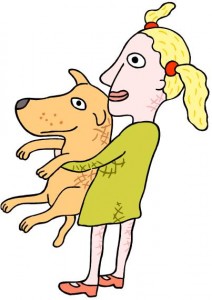Entries Tagged 'website copywriting' ↓
June 8th, 2011 — copywriting tips, website copywriter, website copywriting
 Take a look at your website.
Take a look at your website.
Have a quick read of it – have you we’d everywhere?
Far too many company websites out there are suffering from a nasty bout of incontinence. Their website copy is littered with we.
“We create wonderful furniture…”
“We take customer service seriously…”
“We have been working in this industry for 40 years…”
Do I look as though I care about any of that?
No!
As a customer looking through your website, I couldn’t give a toss about what your company’s achieved, how big your sales team is or how long you’ve been in business.
There’s only one thing I want to know and that’s what will your product/service do for me?
I want you to talk to me and tell me you’re going to make my life better. I want to hear about how you’re going to save me time, make me more glamorous or save me loads of money.
But to do that you’ve got to ditch the ‘we’ and replace it with ‘you’.
Website copywriting must address your reader at all times and that means writing in the second person.
Want an example?
OK, take a look at this text which I’ve taken from my website:
A Freelance Copywriter Will Increase Your Sales Conversion Rate
Would you like more time to do what you do best?
Do you want increased targeted traffic to your website?
Do you want your brochures and leaflets to produce more quality enquiries?
Many businesses find they simply don’t have the time, confidence or skill to write their own website copy, sales emails or print marketing materials. Often time and money is wasted on expensive advertising which lacks persuasive power. But a freelance copywriter will re-energise your marketing copywriting to help you achieve your goals.
See what I mean? All the way through the text I’m talking to the reader – no ‘we’ anywhere.
Granted I’m a website copywriter (just one of the many copywriting services I offer), but this is an effect that is simple to create.
When composing your web copy:
- Forget about your company
- Write as if you were talking to a customer who was standing in front of you
- Resist the urge to type ‘we’
Using the second person will help you make a connection with your reader. Make them feel as though they are the most important person in the world.
June 1st, 2011 — copywriter, copywriting, copywriting tips, marketing, social media, website copywriter, website copywriting, website design
 As a business owner you want and need customers.
As a business owner you want and need customers.
Ideally those customers will be of the happy variety that come back time and time again and bring all their friends along too.
But how do you make sure your website and customer service can generate that level of customer satisfaction?
When shopping online, people want speed, simplicity and a warm and fuzzy feeling once they’ve completed their purchase.
Other than tracking them all down and giving them a hug, how can you achieve this through your website?
Here are a few ideas.
Speeding it up
Your customers want to reach your site, find their product, and add it to their shopping basket and pay. So making that process as slick and fast as possible is essential.
Let’s start at the beginning.
1. Loading your site
Your website must load as quickly as possible because your customers aren’t going to hang around waiting for you. By reviewing all the images on your site and compressing them you’ll shorten the load time.
2. Payment
Jumping to the final stage of the buying process, you’ll need to offer a range of payment choices. Paypal is a must as it’s fast, safe and very convenient.
Simplicity
A mistake made by many companies is that their website is full of images, graphics, text and adverts making it impossible for the reader to navigate because there’s so much going on they don’t know which way to turn.
Keeping your site simple eases navigation and understanding.
3. Review your text
How readable is your text? By slightly increasing your font size you’ll make your site more readable.
4. White space
There’s nothing worse than a website that contains masses of solid text. You might think it conveys to the reader everything they need to know but that’s rather counterproductive because they won’t read it.
If you want someone to look at your site, its content has to be attractive. You can achieve this by:
- Shortening your paragraphs (5 lines or less)
- Add bulleted lists to highlight benefits
- Use sub headings
- Use images
But make sure you mix all these elements up to add variety and interest to your page.
Warm and fuzzy
This is probably the hardest one to achieve. How do you give them that warm and fuzzy feeling?
5. Social media
I’m assuming you’re using social media within your marketing strategy (if not why not?) so make sure you monitor your Twitter stream and Facebook page so when customers ask questions about your products you respond to them quickly.
The other site of this is you’ll also be aware of compliments that come through your social media accounts (because you’ll be monitoring them) so make sure you say thank you.
There’s also a possibility that you’ll also get the off negative comment but because you’re monitoring your social media accounts you’ll be able to instantly make contact with the customer and put the situation right.
6. Get personal and obvious
Many companies get so wrapped up in looking professional they end up projecting a cold and impersonal image.
Customers want to buy from someone they like so by creating a website that shows your personality rather than a stale corporate image will get you noticed.
Being obvious doesn’t mean plastering your website with “buy now” in big red letters. Obvious means making your navigation simple to use so anyone can find their way to the page they want. There’s nothing worse than finding a website that sells the product you want but being unable to fathom out how to buy it.
7. Be chatty
When creating the copy on your website please don’t ‘we’ all over it.
Now sure what I mean? Well it’s quite simple. Take a look at your website and count how many times the word ‘we’ appears. In an ideal world there won’t be any.
Your customer couldn’t give two hoots about you; they want to know what you are going to do for them. So review your content and change the focus. If you’re not sure how to do that, find a professional copywriter who can do it for you. You’d be amazed at the difference it will make. You will instantly become:
- Approachable
- Customer-orientated
- Trustworthy
So there you go, 7 simple but effective ways you can change your website’s effectiveness overnight.
Try them out and come back and tell us how you got on. Do you have any other ideas? If so leave a comment below.
May 18th, 2011 — copywriting tips, email marketing, newsletter, search engine optimisation, seo, website copywriting
 Is yours one of the many businesses out there that sends regular newsletters to your customers?
Is yours one of the many businesses out there that sends regular newsletters to your customers?
You probably spend hours slaving over the content (or get a copywriter to slave away for you) to ensure your message is spot on, you’re offering your readers great information and, of course, the odd offer to encourage them to buy from you.
So what happens once it’s been sent?
If you just broadcast it, forget it and then move on to the next month’s issue you’re missing a HUGE opportunity.
Shall I tell you why?
Using your newsletters to boost your SEO
Let me tell you something about your newsletters.
You already have a strong subject line/header, your content will be SEO friendly (stands to reason as you’re writing about your company, products and services) and it’s original content.
So why not breathe life into your newsletter once it’s been sent rather than forgetting about it?
Placing it within your website will help your SEO no end because you’ll be feeding the Google Monster fresh, original content each and every month – yum.
Of course, you can’t just cut and paste the content into your website; you’ll need to make a few amendments such as:
- Create a new page for each newsletter, so you’ll be treating them like articles.
- Use links within the text (hyperlinks using your keywords) to point to other relevant information within your site or other articles.
- Remove any mentioned of forthcoming events etc. Unlike your newsletter which is transient, your new web page will be around for a long time to come.
- Take out any special offers for subscribers.
- Play around with the layout to make sure it looks attractive. Add sub headings, images and even video to enhance your message.
By repurposing the content in this way you’ll add volume to your website, boost your SEO and offer your readers some great information.
April 25th, 2011 — Content marketing, copywriter, copywriting tips, online marketing, search engine optimisation, seo, SEO copywriter, seo website copywriter, small business web marketing, website copywriting
 Are you the type of person who breaks out into a cold sweat whenever you hear the term search engine optimisation?
Are you the type of person who breaks out into a cold sweat whenever you hear the term search engine optimisation?
To many it seems to be one of those mythical beasts that you can only tame if you’re armed to the teeth with an array of magical implements.
Well fear not for your knight(ess) in shining armour is here to save the day.
There are 5 very simple SEO checks you can make right now. Open up another browser window and pull up your website.
Ready?
OK, first things first. Let’s take a look at your website structure:
1. Looks aren’t everything
That’s something my mum was constantly telling me when I was growing up.
Take a look at your website – this one is especially pertinent for all owners of custom built websites. For many business owners the ‘look’ of their website is at the top of their list. It’s the part of the process that takes the biggest budget because they want theirs to be prettier than anyone else’s.
The problem with custom builds is that, sometimes, looks are at the expense of SEO, especially if you’ve been seduced by flash. Yes, it looks lovely but unless you’ve got some magic going on in the background coding it’s not going to help your search engine optimisation one jot.
Template websites – love them or loathe them – tend to be more SEO friendly from the start. If there are any web designers out there who want to disagree or comment further please do so, I’d love to hear your take on the design vs SEO debate.
Next we move on to how to get found in the first place, yup, the dreaded keyword research bit.
2. Keywords
Remember this post is all about simple SEO checks so I’m not going to delve into the realms of thorough keyword research.
Take a minute to jot down the top 3 words that you would use as a Google search to find your website.
For example I would choose copywriter, freelance copywriter and possibly Suffolk copywriter to get a geographical tag in there. Next ask a friend or colleague to do the same, in fact ask as many people as you like to do the same and eventually you’ll have a list of keywords.
You may not think that’s very scientific but it will give you keywords that real people would search under for you.
Next you do the hard bit and work out how competitive they are and which ones are the best to tackle (you’ll need to use something like Google’s free keyword research tool for this). The chart below should help you work that bit out.

It’s also a good idea, before you make any changes to your site, to search under the terms you decide on and write down your current ranking so you can watch in awe as your site rises ever higher.
That’s your keywords done, so what’s next? Well it’s back to your website.
3. All present?
If you want your site to rank for your identified keywords they need to be in your copy. That doesn’t mean cramming them into every sentence on the page. But rather weave them into the text in a couple of places.
Your headings and sub headings are always a good place to put them and in your title tags.
OK, so now you’ve got your words in your website copy, what’s next?
4. Power content
The next thing to do is write a page or blog post centred on your keywords (one for each keyword). Again that doesn’t mean stuffing, but using your keywords wisely (e.g. in a post of about 200-300 words, use your keyword 2 or 3 times).
Try and use it in your headings to give it more prominence. Once you’ve published these on your website you can then use them on your social media sites too (e.g. your Facebook page) and link back to your site using the keywords as your anchor text links.
With me so far? For the next bit you’ll need a bit of help.
5. Get votes
Every link that comes into your website acts like a vote of confidence in Google’s eyes. The more you have, the more authoritative you are.
So ask friends and colleagues to link to you (like a link exchange) using contextual anchor text links.
OK, so these 5 tips aren’t the most comprehensive SEO techniques but they can and will make a difference. So what have you go to lose? Give them a try and the come back and let me know how you get on.
April 22nd, 2011 — copywriter, copywriting tips, search engine optimisation, seo, SEO copywriter, seo website copywriter, website copywriter, website copywriting
 The world of search engine optimisation can be confusing.
The world of search engine optimisation can be confusing.
Identifying your keywords, looking at your site structure and building back links are all vital aspects if your SEO strategy is going to work.
But what can you do about your copy? Making sure it’s written by a professional SEO copywriter is obviously a step in the right direction but here’s a list of 8 quick tips you can use to optimise your web copy.
Open a second browser window and take a look at your web copy as you read – is there something you can improve?
1. Headline
As with any form of marketing, your headline must grab attention and draw your reader in. It must sell you, your company and your products and services.
A weak headline will result in people navigating away from your site to one that offers them what they’re looking for.
2. First impressions
Assuming your headline has caught their attention it’s vital that the rest of your website does. Do the first few lines of text live up to their expectations? Do the images you use compliment or detract from your copy?
To work, all the elements of your web page have to compliment each other and work together.
3. WIIFM?
This is the question that sits firmly in the forefront of your reader’s mind – what’s in it for me?
Make sure you tell them the benefits of your product/service straight away. That’s not the features here we’re talking about what it is that your product/service will do for them – save them time, save them money, make them more attractive, make them healthier etc. Something that they will value (that’s why it’s so important you know who your customers are and what they want).
4. Easy on the eye
This is where readability comes in. People don’t generally like reading from a screen so you must ensure your information is accessible and readable. To help you reader skim your content for the most relevant points use headings and sub headings, break the text up with bulleted lists and use images to help get your message across.
Above all keep Bryan Eisenberg’s 5 R’s of Search Engine Marketing in your mind:
- Relevance (make sure your copy is relevant to your market)
- Reputation (great content will build your reputation and encourage links)
- Remarkable (only truly great copy will build your reputation)
- Readability (use the right HTML, tags, headlines, bullets, sub headings, font size etc.)
- Reach (don’t cast your net too wide)
5. We
How many times does ‘we’ appear on your website?
A website full of ‘we’ comes across as being very self-centred. The reader doesn’t care about you; they care about what you’re going to do for them.
Go through your copy and change your ‘we’ for ‘you’ to shift the focus firmly on your customer.
6. Voice
The tone of voice you use is very important. The information you provide has to be accessible so avoid jargon. Also to make it more readable avoid using the passive voice. Be active and involve your reader in your text.
7. Other wording
The wording on your website isn’t just confined to your body text. There are also ALT tags, captions, banner text etc. Are the words here really adding value?
8. Hypertext
The hypertext links are the words you use to link out to other relevant information. Make sure you use your keywords within these links to get the most value from them.
That is a quick and simple list of things you can do on your website to help attract visitors and boost your conversion rate. How many are you missing on your website?
 Take a look at your website.
Take a look at your website.
 As a business owner you want and need customers.
As a business owner you want and need customers. Is yours one of the many businesses out there that sends regular newsletters to your customers?
Is yours one of the many businesses out there that sends regular newsletters to your customers? Are you the type of person who breaks out into a cold sweat whenever you hear the term search engine optimisation?
Are you the type of person who breaks out into a cold sweat whenever you hear the term search engine optimisation? The world of search engine optimisation can be confusing.
The world of search engine optimisation can be confusing.




